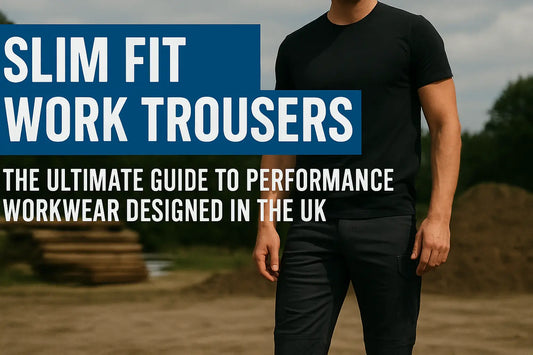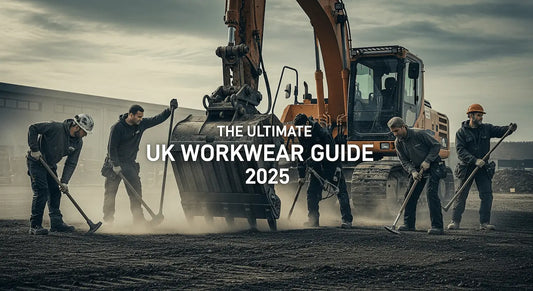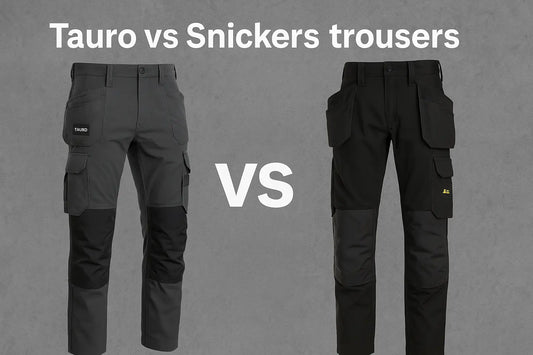
ISO, EN-ISO, and BS-EN-ISO Standards in Workwear and PPE
Why Standards Matter for Health and Safety Teams
Health and Safety (H&S) teams have a legal and ethical obligation to protect workers from occupational hazards. In construction, manufacturing, engineering, and beyond, the right Personal Protective Equipment (PPE) is crucial. However, PPE only serves its purpose if it meets certain recognised standards. That’s where ISO, EN-ISO, and BS-EN-ISO notations come in.
Understanding ISO, EN-ISO, and BS-EN-ISO
-
ISO (International Organization for Standardization)
A global body that develops voluntary international standards to ensure consistency, quality, and safety in products, services, and systems. -
EN-ISO
When an ISO standard is adopted by the European Union (EU), it becomes EN-ISO. This indicates the standard aligns with EU legislation (particularly relevant for PPE under Regulation (EU) 2016/425). -
BS-EN-ISO
When the British Standards Institution (BSI) adopts the EN-ISO standard, it gains the BS-EN-ISO designation. This ensures compliance with UK-specific regulations, including those enforced by the Health and Safety Executive (HSE).
By the time a standard is labelled BS-EN-ISO, it has been validated at the international, European, and British levels, making it the gold standard for health and safety compliance in the UK.
Core PPE Standards and Their Classifications
Below is an overview of the most common standards applicable to workwear and PPE, including expanded classification details vital for H&S professionals.
| Standard | Description | Source |
|---|---|---|
| EN ISO 20471 | High-visibility clothing used in hazardous environments | ISO → EU Adoption |
| BS EN ISO 20471 | High-visibility clothing as adopted in the UK | BSI → UK Adoption |
| EN ISO 11612 | Clothing that protects against heat and flame | ISO → EU Adoption |
| BS EN ISO 11612 | Heat- and flame-resistant clothing (UK) | BSI → UK Adoption |
| EN ISO 20345 | Safety footwear (e.g., toe cap, slip resistance) | ISO → EU Adoption |
| BS EN ISO 20345 | Safety footwear (UK) | BSI → UK Adoption |
| EN ISO 21420 | General glove requirements (ergonomics, innocuousness) | ISO → EU Adoption |
| EN 388 | Gloves protecting against mechanical risks | EU PPE Regulation |
| EN 149 | Filtering facepieces (respiratory masks) for solid and liquid aerosols | EU PPE Regulation |
Below, we explore key PPE categories in more detail, including relevant classes, performance levels, and what Health and Safety managers need to watch for.
1. High-Visibility Clothing: EN ISO 20471 / BS EN ISO 20471
Scope: This standard outlines the requirements for high-visibility clothing to visually signal the user’s presence in daylight and under illumination in the dark.
Classification by Risk
- Class 1: Lowest level of visibility (e.g., minimal reflective strip area). Suitable for lower-risk environments or tasks involving slower-moving vehicles.
- Class 2: Intermediate visibility, requiring a moderate area of reflective tape and fluorescent material. Often used by warehouse workers or those near moderate traffic speeds.
- Class 3: Highest level of visibility for the most hazardous environments (e.g., roadside work with fast-moving traffic). Garments must have the greatest area of fluorescent and retroreflective material, often including sleeves.
Key Performance Factors
- Retroreflective Tape Performance: Must meet minimum reflectivity levels when tested from various angles.
- Background Material: Fluorescent colour must retain brightness after washing, UV exposure, etc.
- Design Features: Placement of reflective strips around the torso and arms for 360° visibility.
Health and Safety Note:
• Verify garments are labelled BS EN ISO 20471 in the UK.
• Inspect regularly for signs of wear, as compromised reflectivity reduces protection.
Reference: ISO 20471 Standard
2. Heat and Flame-Resistant Clothing: EN ISO 11612 / BS EN ISO 11612
Scope: This standard sets minimum performance requirements for clothing protecting workers from heat (convective, conductive, or radiant) and flame.
Heat Performance Codes (A, B, C, D, E, F)
- A1/A2 (Flame Spread): A1 indicates surface ignition resistance; A2 indicates edge ignition resistance.
- B (Convective Heat): B1/B2/B3, with B3 offering the highest protection.
- C (Radiant Heat): C1–C4 based on increasing levels of protection.
- D (Molten Aluminium Splash): D1–D3.
- E (Molten Iron Splash): E1–E3.
- F (Contact Heat): F1–F3.
Each letter corresponds to a specific type of thermal hazard, and the numerical classification indicates the performance level within that hazard category (e.g., B3 is higher protection than B1).
Health and Safety Note:
• Understand the specific hazards in your workplace—whether it’s molten metal (D/E) or high-contact temperatures (F).
• Look for garments tested to the relevant performance codes.
• Pair heat-resistant garments with complementary PPE, such as heat-resistant gloves conforming to EN 407.
Reference: BSI – BS EN ISO 11612
3. Safety Footwear: EN ISO 20345 / BS EN ISO 20345
Scope: These standards cover safety requirements for protective footwear used in industrial settings.
Safety Classifications (S1, S2, S3, S4, S5)
- S1: Basic protective toe cap (200 Joules impact), antistatic properties, heel energy absorption.
- S2: Same as S1 but includes water-resistant uppers.
- S3: Adds midsole penetration resistance to S2 requirements (often steel or composite midsole).
- S4: Similar to S1 but made entirely from polymer or rubber (waterproof).
- S5: Same as S4 but with additional midsole penetration protection.
Additional Footwear Markings
- P: Penetration-resistant midsole.
- WR: Water-resistant footwear.
- HI/CI: Insulation against heat/cold.
- SRC: Slip resistance tested on ceramic + water/detergent and steel + glycerine (often the highest slip-resistance rating).
Health and Safety Note:
• Select footwear with the correct classification for your environment (e.g., S3 for construction sites with sharp debris).
• Check the slip-resistance rating, especially in workplaces with wet or oily floors.
• Ensure consistent compliance; footwear must be replaced at recommended intervals.
Reference: ISO 20345 Standard
4. Protective Gloves: EN ISO 21420 and EN 388
EN ISO 21420 sets general requirements for design, innocuousness (ensuring no harm from materials), and comfort. EN 388 specifically addresses mechanical risks:
- Abrasion (1–4)
- Cut (1–5 or A–F under newer standards)
- Tear (1–4)
- Puncture (1–4)
- Cut Resistance – TDM Test (A–F)
Performance Levels Example
A glove marked 4X42C might indicate:
• 4 for the highest abrasion resistance.
• X (not tested for blade cut in that method).
• 4 for tear resistance.
• 2 for puncture resistance.
• C for TDM cut resistance (level C in the A–F scale).
Health and Safety Note:
• Choose gloves offering the right balance of abrasion and cut resistance without sacrificing dexterity.
• Different tasks (e.g., glass handling vs. assembly work) have varied glove requirements.
• Always re-check markings after glove laundering or chemical exposure, as performance can degrade over time.
Reference: EN ISO 21420 / EN 388 Documentation
5. Respiratory Protection: EN 149
Scope: Defines filtering facepiece respirators (FFP), often categorised as FFP1, FFP2, or FFP3 based on filter efficiency.
FFP Classifications
- FFP1: Minimum filtration (~80% efficiency). Suitable for lower levels of dust or non-toxic particles.
- FFP2: Higher filtration (~94% efficiency). Recommended for moderate levels of dust or aerosols. Comparable to N95 in the US.
- FFP3: Highest level of filtration (~99% efficiency). Recommended for toxic, carcinogenic, or highly hazardous particulate environments.
Health and Safety Note:
• Fit testing is crucial; an FFP3 mask is only as effective as its seal.
• Ensure the respirator is CE-marked (UKCA in the UK post-Brexit), referencing EN 149 compliance.
• Regularly replace disposable masks according to manufacturer’s guidelines and job-specific hazards.
Reference: European Commission – Personal Protective Equipment
Legal and Compliance Implications
-
Regulatory Requirements:
The UK’s Personal Protective Equipment at Work Regulations (PPER) 2022 and the EU Regulation (EU) 2016/425 mandate employers provide compliant PPE. HSE enforcement can lead to notices or prosecutions if PPE standards are not met. -
Insurance and Liability:
Non-compliance may invalidate insurance and expose organisations to liability claims. -
Worker Training:
Health and safety teams must ensure training on correct usage, maintenance, and replacement intervals of PPE. -
Record-Keeping:
Maintain documentation of PPE inspections, supply logs, and any test certifications from suppliers.
Selecting Compliant Gear: Best Practices
- Verify Labels: Look for BS EN ISO notations on product labels, documentation, or packaging.
- Supplier Credentials: Purchase from reputable suppliers who can provide valid test reports (e.g., a Declaration of Conformity).
- Risk Assessment Match: Always correlate the required PPE class or performance level to the specific hazard identified in a formal risk assessment.
- Maintenance and Replacement Schedules: Develop standard operating procedures (SOPs) for cleaning, storage, and disposal. For example, high-vis garments lose effectiveness if the reflective tape is cracked or soiled.
Example: Tauro Workwear Compliance
For tradesmen seeking certified gear, Tauro Workwear offers products with BS-EN-ISO labels covering various categories—high-vis, flame-resistant, and safety footwear. This simplifies compliance for health and safety teams, ensuring staff are properly equipped from day one.
Sources and Further Reading
-
International Organization for Standardization (ISO):
https://www.iso.org/ -
European Commission – Harmonised Standards:
https://ec.europa.eu/growth/single-market/european-standards/harmonised-standards_en -
British Standards Institution (BSI):
https://www.bsigroup.com/ -
ISO 20471:2013 (High Visibility):
https://www.iso.org/standard/42883.html -
BS EN ISO 11612 (Heat and Flame Protective Clothing):
https://shop.bsigroup.com/ProductDetail?pid=000000000030292427 -
ISO 20345:2011 (Safety Footwear):
https://www.iso.org/standard/53438.html -
EN ISO 21420:2020 / EN 388:2019 (Protective Gloves):
https://www.iso.org/standard/70464.html -
European Commission – Personal Protective Equipment (Regulation (EU) 2016/425):
https://ec.europa.eu/growth/sectors/mechanical-engineering/personal-protective-equipment_en -
HSE – Personal Protective Equipment (PPER) 2022:
https://www.hse.gov.uk/ppe/
Conclusion
For Health and Safety teams, understanding ISO, EN-ISO, and BS-EN-ISO standards is vital. They represent a carefully vetted series of checks ensuring that workwear and PPE meet high benchmarks for performance and safety. By aligning your organisation’s procurement and training practices to these standards, you safeguard worker welfare, maintain legal compliance, and uphold a robust safety culture.





